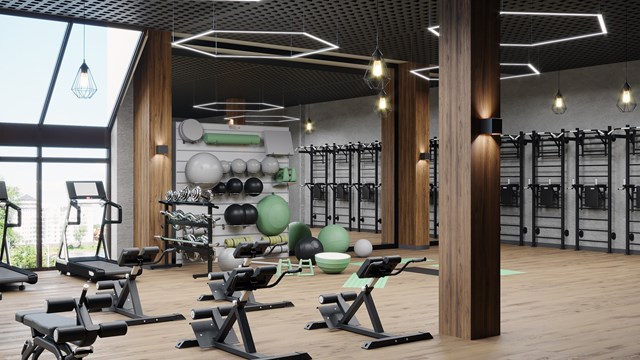As the old saying goes, you never get a second chance to make a first impression, and for homebuyers, that first impression is almost always the view from the street. No matter how deluxe the accommodations inside, if the property’s exterior is less than desirable, a buyer’s mind is often made up before they enter the front door—if they even bother to go that far.
Especially in times of economic stress, housing associations and residents are compelled to maximize the curb appeal of their property in order to compete in a market that still has a long road to recovery ahead. While this need not cost thousands of dollars, it's a little more complex than just planting some geraniums and calling it a day.
How your building or association presents itself to passers-by and the world at large—it's 'curb appeal'—has a direct effect on resident morale, pride of ownership, and even property values. Let's take a look at how to spruce up your property without paying through the nose.
You Had Me at Hello
The concept of curb appeal is similar to that of any other commodity that one tries to sell—homeowners often improve the condition of their homes in an effort to attract more potential buyers.
“You want to project a good first impression that will capture potential buyers at the curb,” says Linda Minogue of Room Refreshments in Naperville. “That’s important, because they simply won’t get past the curb if they don’t like what they see. You want to get them inside, into the threshold of the home to make a connection.”
“When you’re selling your home, it’s no longer your home, but a product,” says Margie Gregori of MG Home Highlights in Orland Park. “Within [the first] ten seconds of seeing a property, the buyer has already made up their mind about it—so you want to give a good first impression within those first ten seconds.”
Curb appeal can also help a seller’s home stand out from other homes that could act as competition. “Your house has to stand out and look better than everything else in the area,” Minogue says. “Especially the other houses that are for sale. It’s good for sellers to see what the competition has.”
According to Gregori, attention to curb appeal also gives prospective buyers the sense that a home has been well-cared for and needs less work upon move-in, which may make it more attractive than similar properties that give off more of a 'fixer-upper' vibe.
“Curb appeal tells people that a house is well-maintained,” says Gregori. “If potential buyers pull up, and it doesn’t look like the owners have taken care of it or enjoyed living there, the owners may lose the sale. It’s very important to make a buyer want to go in.”
All the Yard's a Stage...
Although Chicago winters can pose quite the challenge for commuters and travelers, Minogue says that no matter what, snow and ice must be removed from around a home prior to a showing. “The house has to be pristine no matter what season it is, even if it’s in winter when there is a lot of snow.”
In warmer seasons, it's the landscaping that can make or break a buyer’s first impression. “Landscaping shouldn’t be overgrown in a growing season,” Minogue continues. “A very common problem I see is with people who have lived in a house for over 20 years—you can’t see the front of their house” on account of overgrown shrubbery and unpruned vegetation. “If you can’t see it, you can’t sell it,” Gregori says. “You need to trim bushes by the front door.”
Gregori also suggests adding plants and ground cover that complement the color of a house, drawing in the buyers’ eye. “In the winter months, I would recommend replenishing your mulch,” she says, “making it more texturized and fluffy. Use a red-colored mulch, or something similar that will pop visually.”
Potted plants are also a good, low-budget option for punching up curb appeal, adds Minogue. “You can get plant material or flowers in pots for relatively cheap,” adding color to your building without breaking the bank. “Yellow is a good color for flowers in pots,” says Gregori. “It’s a friendly color and goes with just about everything.”
Minogue cautions that if a condo is currently vacant, landscaping is even more important—an ill-kept, neglected-looking front or back yard can be a deal-breaker. “If a unit is vacant, you have to be careful,” she says. “In the growing season and hot weather you have to watch plants” to make sure they're watered adequately and not withering in the sun.
Minogue also suggests that garage doors be closed during an open house or home showing, and that the asphalt on the unit's driveway be clean, clear, and in good repair, free of cracks or buckling.
Both Minogue and Gregori stress the importance of a unit’s front door during a home sale. “It costs less than $25 to put a new coat of paint on a front door,” Minogue says. Again, she notes that color—as long as it's within the parameters spelled out in the condo or association's aesthetic guidelines—can have a huge positive impact on curb appeal. While red and green are perennially popular choices, she has noticed an uptick in the number of sellers choosing less-common door colors, such as aqua. “Aqua-colored front doors are great because it’s unexpected and gets the buyers’ eye up there,” she says.
Gregori adds that although the front door should draw a buyer into the home, it is also important for buyers to coordinate the color of their doors with the rest of their home. “Owners can paint the front door a bold color depending on what color the rest of the building is,” she says. “We want to appeal to a wide variety of people, but in doing so we want color, texture and balance. We want to put colors in front of the house to draw the buyer in.”
Gregori says that another way to freshen the appearance of a condo exterior is to paint the shutters—something that many sellers do not immediately think of when trying to improve the appearance of their home. “A great way to make curb appeal that people don’t think of is coordinating the colors of shutters and the front door together,” she says. “If you have shutters already, paint them—it makes a huge difference.”
Important as color is however, the real estate professionals stress that owners should always be careful not to overuse bold or trendy hues, and keep the majority of their surfaces and accents in a neutral palette. Using more neutral colors also appeals to a greater audience, widening the group of perspective buyers of a home.
“You don’t need to make extensive use of decorative colors,” says Gregori. “There’s a difference of using red inside and outside; you shouldn't use red for inside walls. Earth-tones will make it more move-in ready - and they have to be the right earth tones.”
Gregori also suggests that sellers power wash the exterior of their unit, porch and sidewalks to get rid of any accumulated grime. Power washing can also take age off of some materials. “Things can be old but they need to be maintained,” she says.
It's the Little Things
According to Minogue, it is also important to give some thought to smaller things in a home’s entryway—even such seemingly mundane items as the doorbell, house numbers and the welcome mat. Brass should be polished, numbers should be straight and well-placed, and worn or soiled mats should be replaced. Gregori agrees, adding that homeowners should also evaluate the condition of their front door screen prior to showing their home. “If there are holes in the screen, it may be best to just remove it and let the front door show,” she says.
The first step in marketing any condo or townhome these days is online. The pros stress that since so much home advertising is done online, having good quality, illustrative pictures of a home for sale is vitally important. “The number-one way to get showings is to get good pictures of the home,” says Gregori. “The owners need to take the photos on a bright, sunny day, with a beautiful sky in the background, no cars or boats in the driveway, and the front door clear.” Without the good first impression generated by great photos, Gregori says condo hunters may not even bother visiting the home.
Won't You Be My Neighbor?
As important as it is for sellers to get their properties up to scratch prior to putting them on the market, some of the most common difficulties sellers run into aren't linked to their own unit so much as the units and grounds around it. If a condo or townhome owner is trying to sell their home and an adjoining unit or the association in general is not well-maintained, this can cause the seller’s home to decrease in value.
If a good rapport between neighbors isn't already in place, confronting this type of challenge can be awkward. “Some people are comfortable just asking their neighbors to clean up when they put their house on the market, but there’s no right or wrong answer,” says Minogue. “Sometimes neighbors can be alienated by that approach, and in some circumstances it makes things worse.”
Gregori adds that a possible approach for sellers trying to negotiate with their neighbors is to explain how well-maintained homes increase property values not only for the current sellers, but for the neighborhood as a whole.
“You can nicely say, ‘We’re putting our unit on the market and want to appeal to a wide variety of people. In order to do that, we need the homes next to ours to be maintained and cared for so our property value goes up’,” Gregori said. “This in turn helps the value of the entire neighborhood. One day they may want to sell their own home.”
According to Gregori, sometimes townhome owners have very little flexibility when it comes how the outside of their home looks, or how the surrounding grounds are maintained. Because of this, she says it is important for owners to strongly encourage their boards to maintain landscaping and other repairs if they lag behind.
She also points out that some neighborhoods and HOAs do not allow 'For Sale' signs in front yards, which enforces the importance of good marketing on the realtor’s part.
“That’s where the realtor has to really step it up and get it marketed well, do a brochure on it for example,” she says. “You only have one chance to make a good first impression, so you need every piece of the recipe in place to get that particular buyer.”
Rosie Power is a freelance writer and a frequent contributor to The Chicagoland Cooperator.







Comments
Leave a Comment